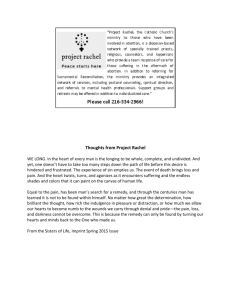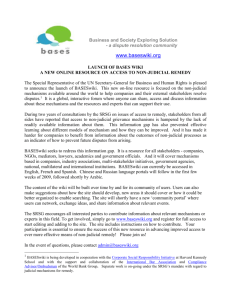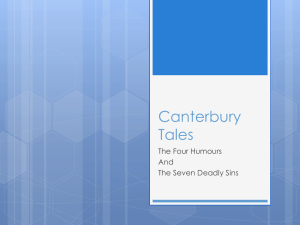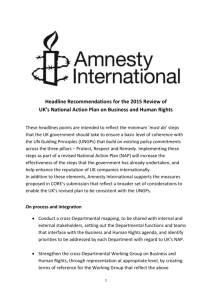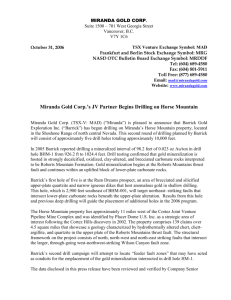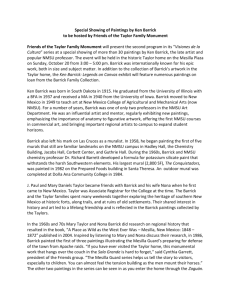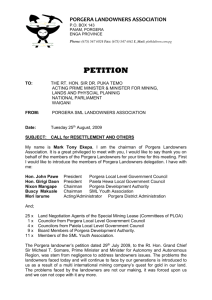MiningWatch Canada to UN High Commissioner for Human Rights
advertisement
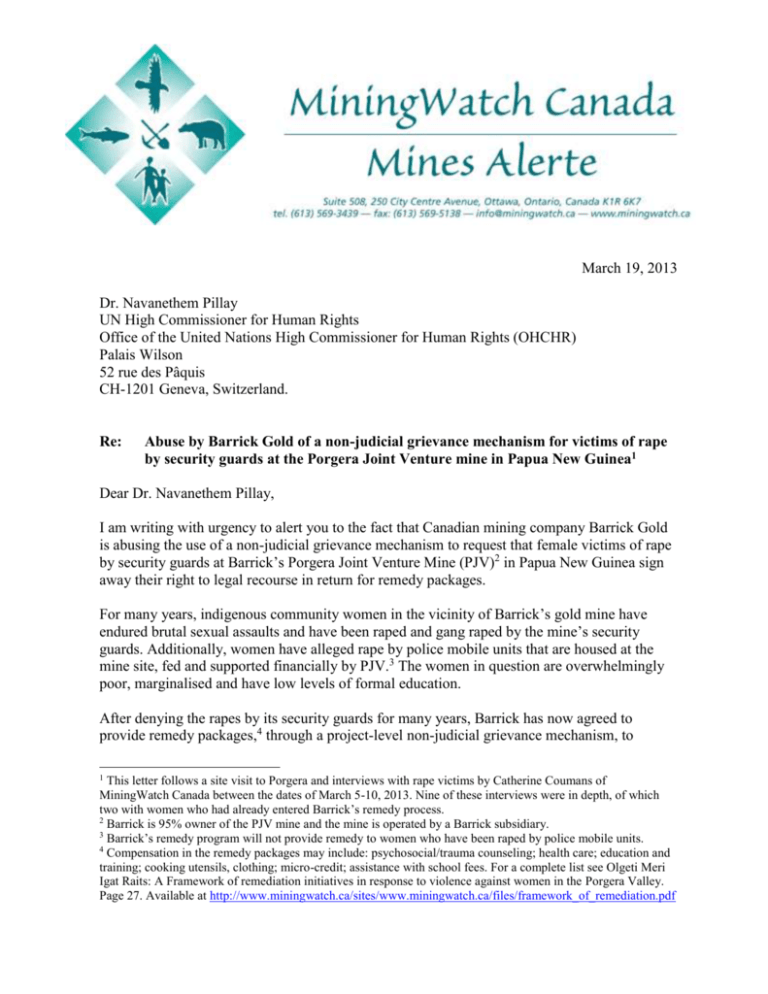
March 19, 2013 Dr. Navanethem Pillay UN High Commissioner for Human Rights Office of the United Nations High Commissioner for Human Rights (OHCHR) Palais Wilson 52 rue des Pâquis CH-1201 Geneva, Switzerland. Re: Abuse by Barrick Gold of a non-judicial grievance mechanism for victims of rape by security guards at the Porgera Joint Venture mine in Papua New Guinea1 Dear Dr. Navanethem Pillay, I am writing with urgency to alert you to the fact that Canadian mining company Barrick Gold is abusing the use of a non-judicial grievance mechanism to request that female victims of rape by security guards at Barrick’s Porgera Joint Venture Mine (PJV)2 in Papua New Guinea sign away their right to legal recourse in return for remedy packages. For many years, indigenous community women in the vicinity of Barrick’s gold mine have endured brutal sexual assaults and have been raped and gang raped by the mine’s security guards. Additionally, women have alleged rape by police mobile units that are housed at the mine site, fed and supported financially by PJV.3 The women in question are overwhelmingly poor, marginalised and have low levels of formal education. After denying the rapes by its security guards for many years, Barrick has now agreed to provide remedy packages,4 through a project-level non-judicial grievance mechanism, to 1 This letter follows a site visit to Porgera and interviews with rape victims by Catherine Coumans of MiningWatch Canada between the dates of March 5-10, 2013. Nine of these interviews were in depth, of which two with women who had already entered Barrick’s remedy process. 2 Barrick is 95% owner of the PJV mine and the mine is operated by a Barrick subsidiary. 3 Barrick’s remedy program will not provide remedy to women who have been raped by police mobile units. 4 Compensation in the remedy packages may include: psychosocial/trauma counseling; health care; education and training; cooking utensils, clothing; micro-credit; assistance with school fees. For a complete list see Olgeti Meri Igat Raits: A Framework of remediation initiatives in response to violence against women in the Porgera Valley. Page 27. Available at http://www.miningwatch.ca/sites/www.miningwatch.ca/files/framework_of_remediation.pdf MiningWatch Canada to UN High Commissioner for Human Rights re: Abuse by Barrick Gold of a non-judicial grievance mechanism for victims of rape by security guards March 19, 2013 page 2 women who allege rape by the mine’s security guards. However, in order to receive these remedy packages women must enter into an agreement in which “the claimant agrees that she will not pursue or participate in any legal action against PJV, PRFA [Porgera Remediation Framework Association Inc.] or Barrick in or outside of PNG. PRFA and Barrick will be able to rely on the agreement as a bar to any legal proceedings which may be brought by the claimant in breach of the agreement.”5 A seriously flawed remedy program Based on information gathered by MiningWatch Canada during a site visit between March 510, 2013, there are serious concerns with the remedy program Barrick has put in place. These concerns include: use by remedy program staff of a language not commonly understood or spoken by local women; lack of decision making authority by rape victims regarding the form of remedy they will receive;6 remedy is not tailored to the harm that has been suffered;7 remedy is not culturally appropriate;8 lack of understanding by women of the process in which they are engaged;9 women do not have access to independent (not paid for by Barrick) legal representation in the process; women are not always given copies of documents they have signed. Additionally, the remedy program is not transparent for the women who participate in it, or for outside observers.10 Furthermore, lack of awareness by local women of the program was apparent as nearly half of the women interviewed by MiningWatch Canada who were not already engaged in the remedy program had not heard of the program. Finally, these flaws may have been avoided if Barrick had been willing to engage core local and international stakeholders in the design and implementation of the framework. In particular Barrick explicitly excluded from consultation the leadership of a grass roots human rights organization in Porgera, the Akali Tange Association (ATA), and the Porgera Landowners Association (PLOA), which represents the landowners in the mine lease area.11 5 Olgeti Meri Igat Raits: A Framework of remediation initiatives in response to violence against women in the Porgera Valley. Page 27. Available at http://www.miningwatch.ca/sites/www.miningwatch.ca/files/framework_of_remediation.pdf 6 For example, one woman reported having told the Complaints Assessment Team she would appreciate receiving a particular remedy from those offered, only to be told later she would be receiving “chicklets” [young chickens] to raise instead. 7 Women indicated a desire for forms of compensation that addressed the specific harms they had suffered as a result of the rape, such as loss of housing. 8 Women reported that a culturally appropriate form of compensation for a transgression as serious as rape would be pigs and the equivalent value of these pigs in cash. 9 For example, women reported not knowing who it was that was making the final decision on the remedy they would receive. 10 The remedy program involves various decision makers, such as a Complaints Assessment Team, an Appeal Committee, and an Independent Expert, all of whom have decision making authority but the names of these individuals are not public and were not known by the women who were interviewed. 11 Leadership of the Akali Tange Association and of the Porgera Landowners Association have met yearly between 2008-2011with Canadian media, spoken at Barrick’s annual general meetings and met with Canadian civil servants and Members of Parliament regarding issues of violence by Barrick’s security forces at the PJV mine. They have also joined with MiningWatch Canada in lodging a formal complaint in March of 2011 – addressing the rapes among other issues – with Canada’s National Contact Point for the OECD Guidelines for Multinational Enterprises. See: http://oecdwatch.org/cases/Case_210 MiningWatch Canada to UN High Commissioner for Human Rights re: Abuse by Barrick Gold of a non-judicial grievance mechanism for victims of rape by security guards March 19, 2013 page 3 These serious flaws in the remedy program make it all the more pressing that women who accept remedy packages not be required to sign away their right to take legal action with regard to the rapes they have endured. Abuse of women’s rights to due legal process: the remedy process should not be used as a vehicle by which to secure legal indemnity for Barrick Gold The women who have endured rape by Barrick’s security guards have suffered a gross violation of human rights and a criminal offence. What Barrick is offering through its project level grievance procedure cannot be compared to an “out of court settlement.” These women have not benefitted from any of the protections or safeguards provided by a legal procedure or a court of law and if they accept what Barrick is offering them they never will, as they must sign away their right to take legal action in regard to the harm they have suffered. The rights of the women who have been harmed should not be violated again, even as they receive remedy for the first violation. While MiningWatch Canada believes that Barrick should offer compensation for the harm that has been caused by its security guards, there should be no conditionality attached to the offer of remedy. A remedy package should be offered to compensate for a harm that has been suffered; it should not be used as a transaction of value. The remedy process should not be used as a vehicle by which to secure legal indemnity for Barrick Gold. Abuse of the Guiding Principles:12 The GPs do not permit impunity by contract Barrick explicitly references the UN Guiding Principles on Business and Human Rights (Guiding Principles) and asserts that the remedy program in Porgera “fully accords with the Guiding Principles on Business and Human Rights.”13 MiningWatch Canada does not believe this to be the case. Nowhere do the UN Guiding Principles envisage the use of non-judicial grievance mechanisms as a way for corporations to secure legal indemnity for gross violations of human rights and criminal acts for which they are responsible. The Guiding Principles envisage a “mix” and a system of remedies (see GP 6, 25), the most fundamental being judicial remedies for the most serious human rights violations, including those that amount to torts or serious crimes (see GP 22, 25, 26). Nowhere do the GPs state or envisage or imply that project level mechanisms would fully satisfy victims’ access to remedy (see GP 29, 30). The Guiding Principles explicitly call on companies to treat the risk of gross human rights violations (e.g. rape) “as a legal compliance issue” (GP 23c). And the GPs state that company “operational-level” grievance mechanisms “should not be used....to preclude access to judicial or other non-judicial grievance mechanisms” (GP 29 Commentary – underline added). 12 UN Guiding Principles on Business and Human Rights http://www.businesshumanrights.org/media/documents/ruggie/ruggie-guiding-principles-21-mar-2011.pdf 13 See http://www.barrick.com/files/porgera/Barrick-corrects-false-claims-concerning-Remediation-Program-atPorgera.pdf MiningWatch Canada to UN High Commissioner for Human Rights re: Abuse by Barrick Gold of a non-judicial grievance mechanism for victims of rape by security guards March 19, 2013 page 4 Not Best Practice There are examples of non-judicial grievance mechanisms that explicitly do not require claimants to give up rights to future legal action. In particular, the United States case of the Hokie Spirit Memorial Fund at Virginia Tech is instructional. Following the 2007 Virginia Tech shooting spree in which a mentally ill student killed thirty-two classmates and faculty members, Virginia Governor Tim Kaine set up the Hokie Spirit Memorial Fund to compensate physically wounded victims and family members of the deceased.14 Victims and relatives were given three options for redress: compensation programs, restitution, and litigation. Families received $100,000 compensation packages for a deceased family member, and injured victims were eligible to receive up to $100,000 (this is Virginia state law’s cap on personal injury claims). Furthermore, families of the deceased were able to seek extra money from a $1.9 million fund created for restitution purposes. These forms of redress did not preclude litigation, as claimants in this compensation scheme “retain[ed] the right to sue in court.”15 As Kenneth Feinberg’s book “Who Gets What” explains, “[A]ll two hundred claimants who received compensation had every right to use the money to hire a lawyer and file a lawsuit against Virginia Tech, [though] only two chose to do so.”16 Another instructive example is the Aboriginal Trust Fund Repayment Scheme in New South Wales, Australia, which provides for a payment to indigenous persons or their descendants concerning wages and other money that was held in trust for them by the Aborigines Protection Board or Aborigines Welfare Board but never repaid to them. The scheme does not require claimants who receive a payment to sign away any legal rights. All claimants who receive a payment are still entitled to pursue legal action. This applies to both the initial 2006 scheme (which individually assessed the amount owed to an individual claimant) and the subsequent 2009 scheme which provided for a fixed ex gratia payment to each accepted claimant.17 Victim’s compensation’s schemes in Australia generally provide for the payment of compensation to victims of serious crime, assessed by an independent tribunal and paid by the government. The payment of compensation does not affect the victim’s right to bring legal proceedings (whether against the government or an individual): Victims Support and Rehabilitation Act 1996 (NSW) section 43(2). However, the compensation may be subject to a condition that the compensation be repaid from any subsequent award of damages in subsequent legal proceedings: s34(1)( c) and the government has a right to receive the compensation for any subsequent award of damages: Victims Support and Rehabilitation Act 1996 (NSW) section 43(3). Similar provisions apply in Victoria: Victims of Crimes Assistance 14 Brenda Waugh, Who Will Choose the End Words? Structuring Justice Amid Tragedy, Washington University Law Journal of Law and Policy, 141-177, 141 (2011). 15 See Kenneth R. Feinberg, Who Gets What, The Hokie Spirit Memorial Fund, at 81. 16 The funds provided through the remedy process were public funds but the principle that claimants should not be required to waive their legal rights to sue Virginia Tech is important. 17 See: http://www.atfrs.nsw.gov.au/frequently_asked_questions http://www.dpc.nsw.gov.au/__data/assets/pdf_file/0016/15541/Guidelines_for_the_Administration_of_the_NS W_Aboriginal_Trust_Fund_Repayment_Scheme_-_30_June_09.pdf MiningWatch Canada to UN High Commissioner for Human Rights re: Abuse by Barrick Gold of a non-judicial grievance mechanism for victims of rape by security guards March 19, 2013 page 5 Act 1996 (Vic) section 51 and South Australia: Victims of Crime Act 2001 (SA) sections 17 and 28. Appeal for Justice Barrick Gold ignored repeated attempts by local leaders from Porgera, who travelled to Canada yearly between 2008-2011, in order to raise concern about the rapes by speaking at Barrick’s annual general meetings in Toronto. Failure by the company to act has allowed the abuses to go on longer than was necessary. While we believe that Barrick should now provide remedy to the women who are coming forward at this time in Porgera, we strongly appeal to the UN High Commissioner for Human Rights to join us in asking Barrick to remove the requirement that women sign away their rights to pursue future legal action if they accept a remedy package for the harm they have endured. Sincerely, Catherine Coumans, Ph.D. Asia Pacific Program Coordinator, MiningWatch Canada Electronic copy furnished to: Mr. James Anaya, Special Rapporteur on the rights of Indigenous Peoples Mr. Pablo De Greiff, Special Rapporteur on the promotion of truth, justice, reparation & guarantees of non-recurrence Ms. Rashida Manjoo, Special Rapporteur on violence against women, its causes and consequences Ms. Rita Izsak, Independent Expert on minority issues Working Group on the issue of discrimination against women in law and in practice Working Group on the issue of human rights and transnational corporations and other business enterprises Lee Waldorf, Human Rights Advisor, UN Women ESCR-Net – Corporate Accountability Working Group Canadian Network on Corporate Accountability European Coalition for Corporate Justice Corporate Responsibility Coalition International Corporate Accountability Roundtable OECD-Watch Amnesty International Human Rights Watch Department of Foreign Affairs Canada Canadian International Development Agency Natural Resources Canada Department of International Trade Canada
